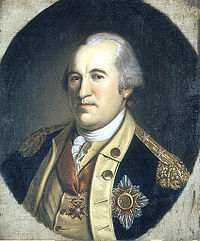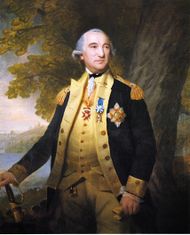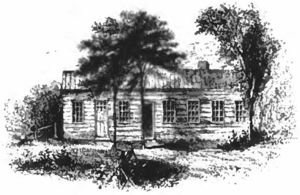Friedrich Wilhelm von Steuben
| Friedrich Wilhelm von Steuben | |
|---|---|
| September 17, 1730 – November 28, 1794 (aged 64) | |
 Friedrich Wilhelm von Steuben, by Charles Willson Peale |
|
| Place of birth | Magdeburg, Duchy of Magdeburg |
| Place of death | Utica, New York |
| Resting place | Steuben Memorial State Historic Site |
| Allegiance | |
| Years of service | 1744-1762; 1777-1783 |
| Rank | Inspector General |
| Battles/wars |
War of 1744
|
Friedrich Wilhelm Augustin Ludolf Gerhard (Frederick William Augustus Henry Ferdinand) von Steuben also referred to as the Baron von Steuben,[1] (September 17, 1730 – November 28, 1794) was a Prussian aristocrat and military officer who served as inspector general and Major general of the Continental Army during the American Revolutionary War. He is credited with teaching the Continental Army the essentials of military drill and discipline.[2] He wrote the Revolutionary War Drill Manual, the book that became the standard United States drill manual until the War of 1812, and served as General George Washington's chief of staff in the final years of the war.
Contents |
Early years
Friedrich von Steuben was born in Magdeburg, Duchy of Magdeburg, within today's Germany, the son of Wilhelm Augustin von Steuben (1699–1783), a lieutenant of engineers. His mother was Elizabeth von Jagvodin. Steuben accompanied his father to the Russian Empire when Friedrich Wilhelm I, King of Prussia and Elector of Brandenburg, ordered Wilhelm into the service of Czarina Anna. The family returned to Prussia after the accession of Frederick the Great to the throne in 1740.
Steuben was schooled in Breslau by Jesuits and, by the age of 16, was an officer in the Prussian military. During the Seven Years' War he was a member of an infantry unit but served primarily as a staff officer. By 1761 he had risen to the rank of captain and was serving in the Prussian general headquarters as aid-de-camp of the king. Capatin Steuben was granted a canonry in Havelberg Cathedral, paying an annual stipend of 1,200 German florins. In 1762 he was selected as one of thirteen members of the "special class for the art of war" (Spezialklasse der Kriegskunst). Headmaster of this class was the king himself. The army was greatly reduced in size at the end of the war, and Steuben was one of many Prussian officers suddenly without work. His Prussian military career would later be exaggerated—he was not one of Frederick the Great's generals—but his experience on a professional general staff, an agency then practically unknown outside of Prussia, would prove to be valuable in his American career.
Service in Hohenzollern-Hechingen

In 1764 Steuben became chamberlain to Fürst Josef Friedrich Wilhelm of Hohenzollern-Hechingen. In 1769, he started using the title of baron, based on a falsified lineage prepared by his father.[3] He was the only courtier to accompany his incognito prince to France in 1771, hoping to borrow money. Failing to find funds, they returned to Germany in 1775, deeply in debt.[1]
In 1776, Steuben's career at Hohenzollern-Hechigen ended in scandal: he was alleged to be gay and was accused of improper sexual behavior with young boys.[3] Whether or not Steuben was actually gay is not known, but the rumors compelled him to seek employment elsewhere.[3] Steuben tried employment in several foreign armies including Austria, Baden, and France.
Steuben traveled to Paris in the summer of 1777. As luck would have it, he had formerly been introduced to the French Minister of War, Claude Louis, Comte de Saint-Germain. The Count, fully realizing the potential of an officer with Prussian general staff training, further introduced him to Benjamin Franklin. Upon the Count's recommendation, Steuben was introduced to George Washington by means of a letter from Franklin as a "Lieutenant General in the King of Prussia's service," an exaggeration of his actual credentials that appears to be based on a mistranslation of his service record. He was advanced travel funds and left Europe from Marseilles.[4]
American Revolution

On September 26, 1777, the Baron, his Italian greyhound, Azor (which he took with him everywhere), his young aide de camp Louis de Pontiere, his military secretary Pierre Etienne Duponceau, and two other companions, reached Portsmouth, New Hampshire and by December 1, was extravagantly entertained in Boston. Congress was in York, Pennsylvania, after being ousted from Philadelphia by the British advance. By February 5, 1778, Steuben had offered to volunteer without pay (for the time), and by the 23rd, Steuben reported for duty to Washington at Valley Forge. Steuben spoke little English and he often yelled to his translator, "Here! Come swear for me!" Colonel Alexander Hamilton and General Nathanael Greene were of great help in assisting Steuben in drafting a training program for the Army, which found approval with Washington.
Training program
Steuben's training technique was to create a "model company", a group of 120 chosen men who in turn successively trained other personnel at Regimental and Brigade levels. Steuben's eccentric personality greatly enhanced his mystique. He trained the soldiers, who at this point were greatly lacking in proper clothing themselves, in full military dress uniform, swearing and yelling at them up and down in German and French. When that was no longer successful, he recruited Captain Benjamin Walker, his French-speaking aide, to curse at them for him in English. Steuben introduced a system of progressive training, beginning with the school of the soldier, with and without arms, and going through the school of the regiment. This corrected the previous policy of simply assigning personnel to regiments. Each company commander was made responsible for the training of new men, but actual instruction was done by selected sergeants, the best obtainable.
Another program developed by Steuben was camp sanitation. He established standards of sanitation and camp layouts that would still be standard a century and a half later. There had previously been no set arrangement of tents and huts. Men relieved themselves where they wished and when an animal died, it was stripped of its meat and the rest was left to rot where it lay. Steuben laid out a plan to have rows for command, officers and enlisted men. Kitchens and latrines were on opposite sides of the camp, with latrines on the downhill side. There was the familiar arrangement of company and regimental streets.
Perhaps Steuben's biggest contribution to the American Revolution was training in the use of the bayonet. Since the Battle of Bunker Hill, Americans had been mainly dependent upon using their ammunition to win battles. Throughout the early course of the war, Americans used the bayonet mostly as a cooking skewer or tool rather than as a fighting instrument. Steuben's introduction of effective bayonet charges became crucial. In the Battle of Stony Point, American soldiers attacked with unloaded rifles and won the battle solely on Steuben's bayonet training.
The first results of Steuben's training were in evidence at the Battle of Barren Hill, 20 May 1778 and then again at the Battle of Monmouth in June 1778. Steuben, by then serving in Washington's Headquarters, was the first to determine the enemy was heading for Monmouth. Washington recommended appointment of Steuben as Inspector General on April 30; Congress approved it on May 5. During the winter of 1778-1779, Steuben prepared Regulations for the Order and Discipline of the Troops of the United States, commonly known as the "Blue Book."[5][6] Its basis was the training plan he had devised at Valley Forge.[7]
Southern campaign
In 1780 Steuben sat on the court-martial of the British Army officer Major John André, captured and charged with espionage in conjunction with the defection of General Benedict Arnold. He later traveled with Nathanael Greene, the new commander of the Southern campaign. He quartered in Virginia since the American supplies and soldiers would be provided to the army from there. During the spring of 1781, he aided Greene in the campaign in the south, culminating in the delivery of 450 Virginia Continentals to Lafayette in June.
He was forced to take sick leave, rejoining the army for the final campaign at Yorktown, where his role was as commander of one of the three divisions of Washington's troops. Steuben gave assistance to Washington in demobilizing the army in 1783 as well as aiding in the defense plan of the new nation. He was discharged from the military with honor on March 24, 1783.
Final years
Steuben became an American citizen by act of the Pennsylvania legislature in March 1784 (and later by the New York authorities in July 1786). With the war over, Steuben resigned from service and first settled on Manhattan Island, where he became a prominent figure and elder in the German Reformed Church. However, even with Congress giving him large sums of money, he still managed to become largely indebted. Thus, Congress gave him a pension of $2,500 a year which he had to keep until his death. Steuben eventually settled on a small estate in the vicinity of Utica, New York, on land granted to him for his military service. He later assisted in the founding of the Society of the Cincinnati and was appointed a Regent for what evolved into the State University of New York. He never married and had no children. He left his estate to General Benjamin Walker and Captain William North, who had served as his aides-de-camp during the war, and with whom he had had an "extraordinarily intense emotional relationship ... treating them as surrogate sons".[8] He is buried at what is now the Steuben Memorial State Historic Site.

Steuben's log cabin residence at Utica[9]
Legacy


Every year in September, the German-American Steuben Parade is held in New York City. It is one of the largest parades in the city and is traditionally followed by an Oktoberfest in Central Park as well as celebrations in Yorkville, Manhattan, a traditionally German section of New York City. The German-American Steuben Parade has been taking place since 1958.[10]
Chicago also hosts a von Steuben Day parade, which is featured in the American movie Ferris Bueller's Day Off. Philadelphia is host to a smaller Steuben Parade in the Northeast of the city.
Generally, Von Steuben Day takes place in September in many cities throughout the United States. It is an often considered the German-American event of the year. Participants march, dance, wear German costumes and play German music, and the event is attended by millions of people.
To further honor Steuben, the Steuben Society was founded in 1919 as "an educational, fraternal, and patriotic organization of American citizens of German background". In the difficult post-World War I years the Society helped the German-American community to reorganize. It is now one of the largest organizations for Americans of German extraction.
A warship, a submarine, and an ocean liner (later pressed into military service) were named in von Steuben's honor. In World War I the captured German ship SS Kronprinz Wilhelm was renamed as USS Von Steuben, and in World War II there was the Dampfschiff General von Steuben, an ill-fated German luxury passenger ship which was turned into an armed transport ship during the war. During the Cold War, the US Navy submarine USS Von Steuben was named for him.
Several locations in the United States are also named Steuben, most of them in his honor. Examples include Steuben County, New York, Steuben County, Indiana, and the city of Steubenville, Ohio.
Several buildings are named for Steuben, among them Von Steuben Metropolitan Science Center in Chicago, Illinois, as well as one of the cadet barracks buildings at Valley Forge Military Academy and College.
Von Steuben is one of four European military leaders who assisted the American cause during the Revolution honored with a statue in Lafayette Square just north of The White House in Washington, D.C.. Other statues of Steuben can be found in Utica, New York, the garden of the German Embassy in Washington, DC, as well as in Potsdam and in Steuben's home town of Magdeburg.
The Steuben House presented to Steuben as a gift for his services in the Continental Army is located At New Bridge Landing in River Edge, New Jersey. Originally belonging to a Loyalist family, the house and surrounding farmland were seized in 1781. It was bought by the county of Bergen in 1996 for $9,000 and preserved as a national monument and public museum. The area around the house is used for both Revolutionary and Civil War re-enactments.
Other tributes to the General include Steuben Field, the stadium of the Hamilton College football team[11]. The field is named for Baron von Steuben who laid the cornerstone of the school acting as Alexander Hamilton's surrogate. Upon graduating, all Hamilton seniors receive a cane as a gift from the college. The cane's design features a tricorn hat at the top of the cane to honor von Steuben.
The various depictions of Steuben in popular (American) media include portrayals by Nehemiah Persoff in the 1979 U.S. TV Miniseries The Rebels, Kurt Knudson in the 1984 TV miniseries George Washington, and being voiced by Austrian-American Arnold Schwarzenegger in the animated series Liberty's Kids.
There are many books on von Steuben. Most recently, Paul Lockhart, a professor at Wright State University in Dayton, Ohio, wrote "The Drillmaster of Valley Forge" as the first comprehensive biography of General von Steuben in more than 80 years.[12] Von Steuben has also been cited in other works, most notably by Randy Shilts in his book Conduct Unbecoming as an early example of a gay man in the military, but the evidence in this matter is inconclusive.[13]
In 2007, a popular documentary DVD was released by LionHeart FilmWorks titled "Von Steuben's Continentals: The First American Army." The 60-minute, live-action documentary details the life, uniforms, camp life, food, weapons, equipment and drill of the Continental Soldier 1775-1781, as taught and developed by Baron von Steuben.[14]
See also
- Revolutionary War Drill Manual
- Sexuality in the Military
- Ushistory.org
References
- ↑ 1.0 1.1 Ushistory.org
- ↑ Thomas Fleming "The Magnificent Fraud," American Heritage, Feb./March 2006.
- ↑ 3.0 3.1 3.2 Philander D. Chase. "Steuben, Friedrich Wilhelm von". American National Biography Online, February 2000.
- ↑ Lockhart, Paul Douglas. The drillmaster of Valley Forge: The Baron de Steuben and the making of the American Army. HarperCollins, New York 2008, p. 50. von Steuben left on Friday, September 26, 1777 from Marseilles on board the "Flamand"
- ↑ ArmyStudyGuide.com Drill and Ceremony #43. Website accessed 9 April 2009
- ↑ The current revision of this book is available for download from the US Army directly The United States Army
- ↑ Lockhart, Paul Douglas (2008), The drillmaster of Valley Forge: The Baron de Steuben and the making of the American Army, New York: HarperCollins, ISBN 0061451630.
- ↑ William B. Skelton. "North, William"; American National Biography Online, February 2000.
- ↑
 Joel Tyler Headley (1900). "Steuben, Frederick William Augustus Henry Ferdinand von". Appletons' Cyclopædia of American Biography.
Joel Tyler Headley (1900). "Steuben, Frederick William Augustus Henry Ferdinand von". Appletons' Cyclopædia of American Biography. - ↑ http://www.germanparadenyc.org
- ↑ NESCAC Football Record Book
- ↑ http://www.harpercollins.com/books/9780061451638/The_Drillmaster_of_Valley_Forge/index.aspx
- ↑ "Uniform Discrimination". Human Rights Watch. http://hrw.org/reports/2003/usa0103/USA0103FINAL-02.htm. Retrieved 2007-09-18.
- ↑ LionHeart FilmWorks, 2010" Source 2", 2/21/2010
External links
- Francis Bowen, Charles Hayward, Lives of Baron Steuben, Sebastian Cabot, and William Eaton (1838)
- Baron Von Steuben: An account of a 19th century visit to America by his German relatives
- Baron Friedrich Wilhelm von Steuben at Find-a-grave.
- http://www.steubensociety.org
| Military offices | ||
|---|---|---|
| Preceded by Thomas Conway |
Inspector General of the U. S. Army May 5, 1778-April 15, 1784 |
Succeeded by William North |